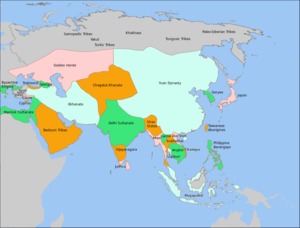الأتراك-المنغول
الأتراك-المنغول Turco-Mongol أو التراث التركي-المنغولي كان تخليقاً ثقافياً نشأ في مطلع القرن 14، بين النخب الحاكمة في الدول التي خلفت الامبراطورية المنغولية مثل خانية چقطاي والقبيل الذهبي. اعتنقت تلك النخب اللغات التوركية ومختلف الديانات مثل البوذية والإسلام، بينما احتفظت بالمؤسسات السياسية والقانونية [[منغول|المنغولية.[1] وقد اعتمد الكثير من الدول اللاحقة في آسيا الوسطى على ذلك الموروث، بما في ذلك الامبراطورية المنغولية، خانية القزخ، خانية قازان، خانية نوگاي، خانية القرم، و امبراطورية المغل.
A much earlier Turco-Mongol tradition existed in prehistory as well, as evidenced by the extensive lexical borrowings from Proto-Turkic into the ancestor of Proto-Mongolic from around at least الألفية الأولى ق.م.. Turkic and Mongolic languages share extensive borrowed similarities in their personal pronouns (e.g. the *b-, *s-, *i- paradigm for 1st, 2nd, and 3rd person, respectively), among other lexical similarities of the type, which seem to date to before this era and already existed before the breakup of Turkic around 500 BCE.[2] Turkic and Mongolic peoples shared a common religion, Tengrism, which dates at least from this ancient period.
A still more ancient period of prolonged language contact between Turkic and Mongolic is indicated by further and more fundamental phonotactic, grammatical, and typological similarities (e.g. synchronic vowel harmony, lack of grammatical gender, extensive agglutination, highly similar phonotactic rules and phonology).[2] In the past, such similarities were attributed to a genetic relationship and led to the widespread acceptance of an Altaic language family. More recently, due to the lack of a definitive demonstration of genetic relationship, these similarities have been divided into at these three known periods of language contact. The similarities have led to the proposal of a Northeast Asian sprachbund instead، التي تضمنت أيضاً عائلات اللغات التنگوسية، الكورية و اليابانوية، بالرغم من أن التوركية والمنغولية تُظهران أكبر تماثل.
انظر أيضاً
- الغزوات والفتوحات المنغولية
- قائمة الأسر والبلدان التوركية
- قائمة الدول المنغولية
- الطورانية
- طارطاريا
- تقسيم الامبراطورية المنغولية
- آسيا الداخلية
- اللغات الألطية
- Sun Language Theory
- النظرية اليافثية
- نظرية الخزر
- الهجرة التوركية
الهامش
- ^ Beatrice Forbes Manz (1989). The Rise and Rule of Tamerlane. Cambridge University Press. pp. 6–9. ISBN 978-0-521-34595-8.
- ^ أ ب Janhunen, Juha (2013). "Personal pronouns in Core Altaic". In Martine Irma Robbeets; Hubert Cuyckens (eds.). Shared Grammaticalization: With Special Focus on the Transeurasian Languages. p. 221.
| هذا article متعلقة بتاريخ آسيا الوسطى هو بذرة. بإمكانك مساعدة المعرفة بأن تنمـِّـيـه. |
